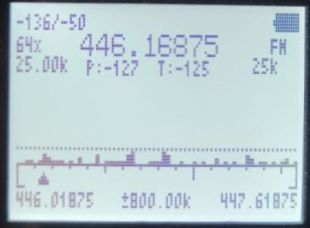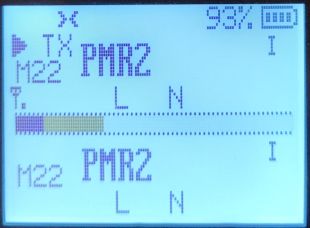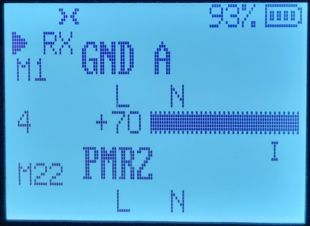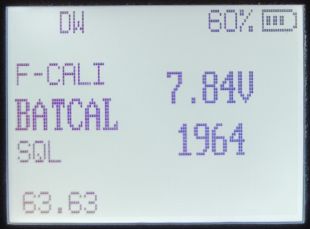uv-k5-firmware-custom
OneOfEleven + fagci OEFW Mod - Spectrum Analyzer - Full Frequency Range TX/RX
MULTIBAND TRANSCEIVER - Download Releases Firmware_packed_vXX (ready to flash)
- QuanSheng alternative Firmware - Latest Version - UV-K5/K6, UV-5R Plus -
Main features:
- many of @OneOfEleven mods, including AM fix
- @fagci spectrum analyzer (F+5 to turn on)
- some other smaller mods introduced by Egzumer
- @RE3CON Multiband full freq ranges 14 MHz - 1789 MHz
set in Makefile:
ENABLE_TX_UNLOCK = 1
Full Frequency Range TX UNLOCK under Hidden Menu -> F-Lock
(Caution about strong interferences on other frequencies by TX)
Go to Wiki to learn more.




❗❗❗You can now calibrate the battery voltage reading in the radio menu.

To enter the calibration:
- turn the radio on while holding PTT and the first side button
- go to BATCAL option and adjust the voltage with UP/DOWN buttons
- confirm the setting, calibration will be saved to EEPROM
Open reimplementation of the Quan Sheng UV-K5 v2.1.27 firmware
This repository is a merge of OneOfEleven custom firmware with fagci spectrum analizer plus my few changes.
https://github.com/OneOfEleven/uv-k5-firmware-custom
https://github.com/fagci/uv-k5-firmware-fagci-mod/tree/refactor
All is a cloned and customized version of DualTachyon’s open firmware found here ..
https://github.com/DualTachyon/uv-k5-firmware .. a cool achievement !)
Use this firmware at your own risk (entirely). There is absolutely no guarantee that it will work on your radio(s). It may even brick your radio(s). In such case you’d need to open your radio and equip it (solder) with an SWD (JTAG) interface wired directly to access the eeprom chip. IF your bootloader get messed up you’ll need to do it to recover.
If you ever recovered the firmware in a bricked WLAN router with JTAG to USB or serial convertor, Serial Wire Debug signals are very similar to this 2 or 3 pin solution. Next to a compatible A/D hardware you need some software stuff e.g. µVision C51V961.EXE (107,294K) or ST-Link. Some EEPROM Programmer are to find on GitHub.
Anyway, have fun.
Radio performance
Please note that the Quansheng UV-Kx radios are not professional quality transceivers, their
performance is strictly limited. The RX front end has no track-tuned band pass filtering
at all, and so are wide band/wide open to any and all signals over a large frequency range.
Using the radio in high intensity RF environments will most likely make reception anything but
easy (AM mode will suffer far more than FM ever will), the receiver simply doesn’t have a good AM amplitude modulation circuide. A FM chip is used on a way that makes it somehow possible to receive AM signals, which results in distorted AM audio with stronger RX’ed signals.
There is nothing more anyone can do in firmware/software to improve that, once the RX gain
adjustment I do (AM fix) reaches the hardwares limit, your AM RX audio will be all but
non-existant (just like Quansheng’s firmware).
On the other hand, FM RX audio will/should be fine. On TX side with 12,5kHz and 25kHz freq mod hub depence on the receivers loudspeaker. Some say its ok while others complains it’s much too quiet and could be way louder even with the maximum modification sensitivity level given for the microfons preamp.
But SSB RX does really work and actually not bad at all. No matter USB or LSB, single side band carrier less because the carrier is always produced by the receiver, usually with manual clarifier adjustment to make the audio signal as much as possible clearly understandable. This kinds of small bandwidth modulations are used for long range communications between stations. Quanshengs demodulator is used with automatically self shifting adjusting the SSB RX clarifier through the existing low coast fm modulator chip. Fagci did a really great job to realize SSB RX with these inexpencive walkie talkies.
For the price they are sold VOB China you wont find any better and Ratel, Baofeng, Pofung, Retevis,… - China transceivers in general for below 100 bugs will never be a Kenwood, Motorola, Yaesu or Icom. But, they are nice toys for the price, fun to play with. Sure not for DX but more than enough for your surrounding area.
User customization
You can customize the firmware by enabling/disabling various compile options, this allows
us to remove certain firmware features in order to make room in the flash for others.
You’ll find the options at the top of “Makefile” (‘0’ = disable, ‘1’ = enable) ..
ENABLE_CLANG := 0 **experimental, builds with clang instead of gcc (LTO will be disabled if you enable this)
ENABLE_SWD := 0 only needed if using CPU's SWD port (debugging/programming)
ENABLE_OVERLAY := 0 cpu FLASH stuff, not needed
ENABLE_LTO := 1 **experimental, reduces size of compiled firmware but might break EEPROM reads (OVERLAY will be disabled if you enable this)
ENABLE_UART := 1 without this you can't configure radio via PC !
ENABLE_AIRCOPY := 0 easier to just enter frequency with butts
ENABLE_FMRADIO := 1 WBFM VHF broadcast band receiver
ENABLE_NOAA := 0 NOAA Weather broadcast alerts (receiption only in North America: Alaska, Canada, U.S.,...) A 1050 Hz Tone call demute the speaker at the beginning of every transmission. The 10 memory channels are replaced with the first 10 PMR channels. Use Sidekey for programable second call tone or >80ms roger beep sound mod with a 1050 Hz tone.
ENABLE_VOICE := 0 voice menu dialogues
ENABLE_VOX := 1 Audio Micro-Voice controlled PTT
ENABLE_ALARM := 0 TX alarms // BROKEN CODE?!
ENABLE_1750HZ := 0 side key 1750Hz TX tone (older style repeater access) // BROKEN CODE?!
ENABLE_PWRON_PASSWORD := 0 power-on password stuff
ENABLE_BIG_FREQ := 1 big font frequencies (like original QS firmware)
ENABLE_SMALL_BOLD := 1 bold channel name/no. (by name + freq channel display mode)
ENABLE_KEEP_MEM_NAME := 1 maintain channel name when (re)saving memory channel
ENABLE_WIDE_RX := 1 full 18MHz to 1300MHz RX (though front-end/PA not designed for full range)
ENABLE_TX_WHEN_AM := 1 allow TX (always FM) when RX is set to AM
ENABLE_F_CAL_MENU := 0 enable/disable the radios hidden frequency calibration menu
ENABLE_TX_UNLOCK := 1 TX all Bands 14 MHz to 1789 MHz. Hidden Menu -> F-Lock -> Select UNLOCKED.
(TX harmonic content will cause interference to other services!)
ENABLE_CTCSS_TAIL_PHASE_SHIFT := 1 standard CTCSS tail phase shift rather than QS's own 55Hz tone method
ENABLE_BOOT_BEEPS := 0 gives user audio feedback on volume knob position at boot-up
ENABLE_SHOW_CHARGE_LEVEL := 1 show the charge level when the radio is on charge
ENABLE_REVERSE_BAT_SYMBOL := 0 mirror the battery symbol on the status bar (+ pole on the right when enabled)
ENABLE_CODE_SCAN_TIMEOUT := 0 enable/disable 32-sec CTCSS/DCS scan timeout (press exit butt instead of time-out to end scan)
ENABLE_AM_FIX := 1 dynamic adjust the frontend gains in AM mode to helo prevent AM demodulator saturation, ignore the on-screen RSSI level (for now)
ENABLE_AM_FIX_SHOW_DATA := 0 show debug data for the AM fix (still tweaking it)
ENABLE_SQUELCH_MORE_SENSITIVE := 1 make squelch levels a little bit more sensitive - I plan to let user adjust the values themselves
ENABLE_FASTER_CHANNEL_SCAN := 1 increases the channel scan speed, but the squelch is also made more twitchy
ENABLE_RSSI_BAR := 1 enable a dBm/Sn RSSI bar graph level inplace of the little antenna symbols
ENABLE_AUDIO_BAR := 1 display an audo bar, VU meter level when TX'ing
ENABLE_COPY_CHAN_TO_VFO := 1 copy current channel into the other VFO. Long press Menu key ('M')
#ENABLE_SINGLE_VFO_CHAN := 1 not yet implemented - single VFO on display when possible
#ENABLE_BAND_SCOPE := 1 not yet implemented - spectrum/pan-adapter
New/modified function keys
- Long-press ‘M’ .. Copy selected channel into same VFO, then switch VFO to frequency mode *
- Long-press ‘7’ .. Toggle selected channel scanlist setting .. if VOX is disabled in Makefile
- or
- Long-press ‘5’ .. Toggle selected channel scanlist setting .. if NOAA is disabled in Makefile *
- Long-press ‘*’ .. Start scanning, then toggles the scanning between scanlists 1, 2 or ALL channels
Some changes made from the Quansheng firmware
- Various Quansheng firmware bugs fixed
- Added new bugs
- Mic menu includes max gain possible
- AM RX everywhere (left the TX as is)
- An attempt to improve the AM RX audio (demodulator getting saturated/overloaded in Quansheng firmware)
- keypad-5/NOAA button now toggles scanlist-1 on/off for current channel when held down - IF NOAA not used
- Better backlight times (inc always on)
- Live DTMF decoder option, though the decoder needs some coeff tuning changes to decode other radios it seems
- Various menu re-wordings (trying to reduce ‘WTH does that mean ?’)
- ..
Compiler
arm-none-eabi GCC version 10.3.1 is recommended, which is the current version on Ubuntu 22.04.03 LTS. Other versions may generate a flash file that is too big. You can get an appropriate version from: https://developer.arm.com/downloads/-/gnu-rm
clang may be used but isn’t fully supported. Resulting binaries may also be bigger. You can get it from: https://releases.llvm.org/download.html
Building
If you have docker installed you can use compile-with-docker.bat, the output files are created in compiled-firmware folder. This method gives significantly smaller binaries, I’ve seen differences up to 1kb, so it can fit more functionalities this way. The challange can be (or not) installing the docker itself.
To compile directly in windows:
- Open windows command line and run:
winget install -e -h git.git Python.Python.3.8 GnuWin32.Make winget install -e -h Arm.GnuArmEmbeddedToolchain -v "10 2021.10" - Close command line, open a new one and run:
pip install --user --upgrade pip pip install crcmod mkdir c:\projects & cd /D c:/projects git clone [https://github.com/re3con/uv-k5-firmware-custom.git](https://github.com/re3con/uv-k5-firmware-custom.git) - From now on you can build the firmware by going to
c:\projects\uv-k5-firmware-customand runningwin_make.bator by running a command line:cd /D c:\projects\uv-k5-firmware-custom win_make.bat - To reset the repository and pull new changes run (!!! it will delete all your changes !!!):
cd /D c:\projects\uv-k5-firmware-custom git reset --hard & git clean -fd & git pull
I’ve left some notes in the win_make.bat file to maybe help with stuff.
Credits
Many thanks to various people on Telegram for putting up with me during this effort and helping:
- Egzumer
- OneOfEleven
- DualTachyon
- Mikhail
- Andrej
- Manuel
- @wagner
- @Lohtse Shar
- @Matoz
- @Davide
- @Ismo OH2FTG
- @d1ced95
- and others I forget
License
Copyright 2023 Dual Tachyon https://github.com/DualTachyon
Licensed under the Apache License, Version 2.0 (the “License”); you may not use this file except in compliance with the License. You may obtain a copy of the License at
http://www.apache.org/licenses/LICENSE-2.0
Unless required by applicable law or agreed to in writing, software
distributed under the License is distributed on an "AS IS" BASIS,
WITHOUT WARRANTIES OR CONDITIONS OF ANY KIND, either express or implied.
See the License for the specific language governing permissions and
limitations under the License.
Example changes/updates



Video showing the AM fix working ..